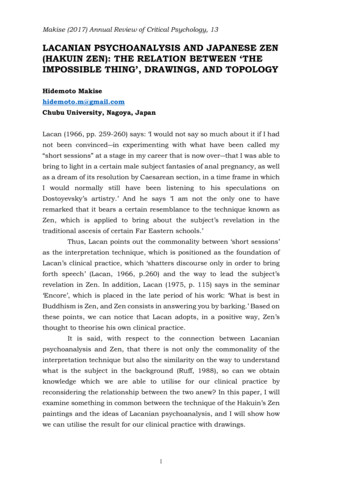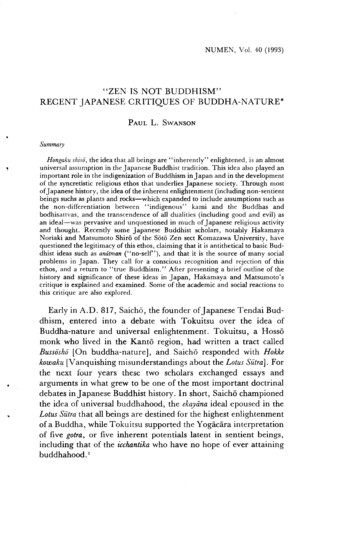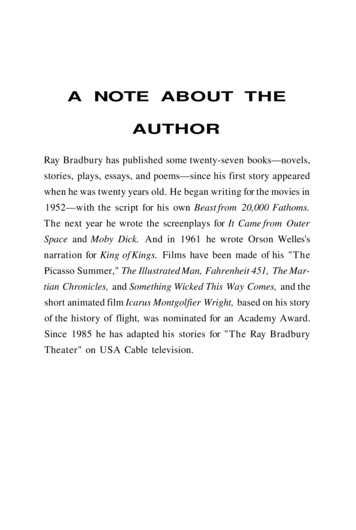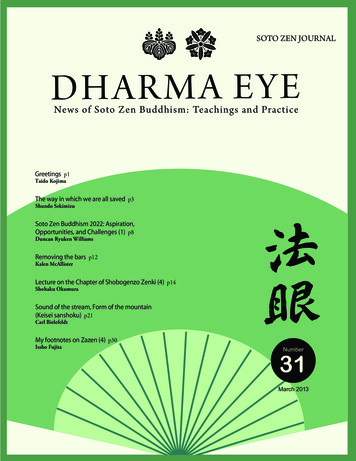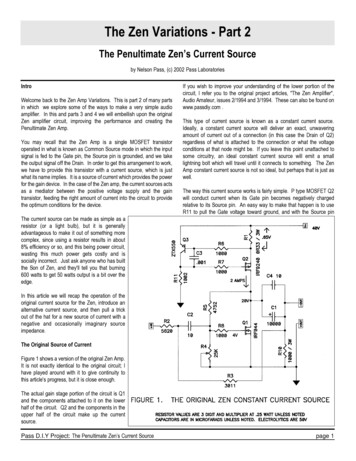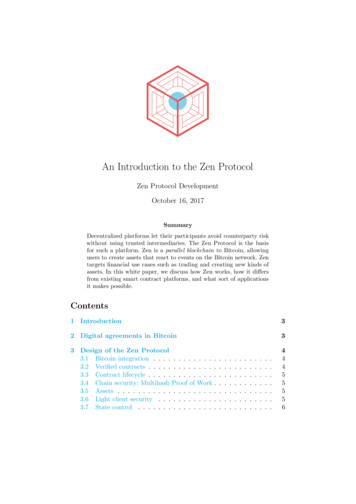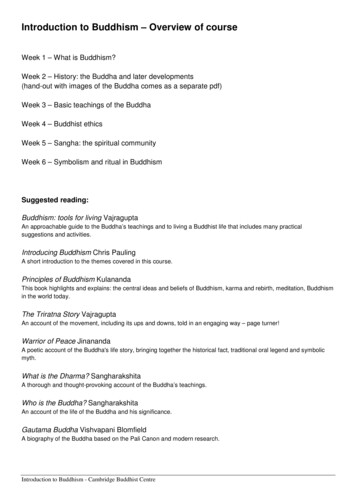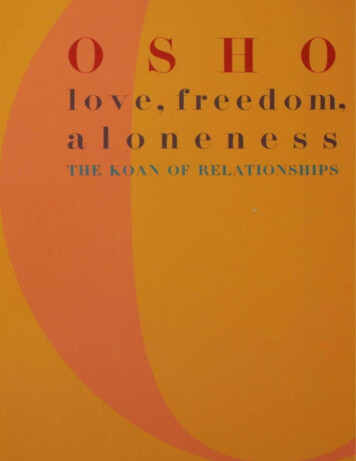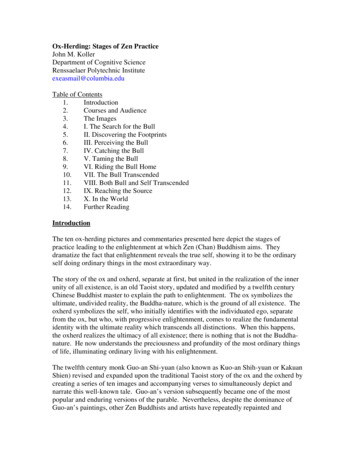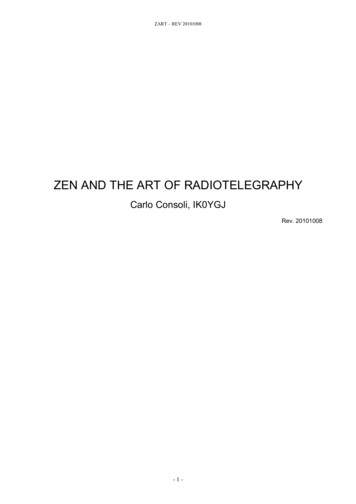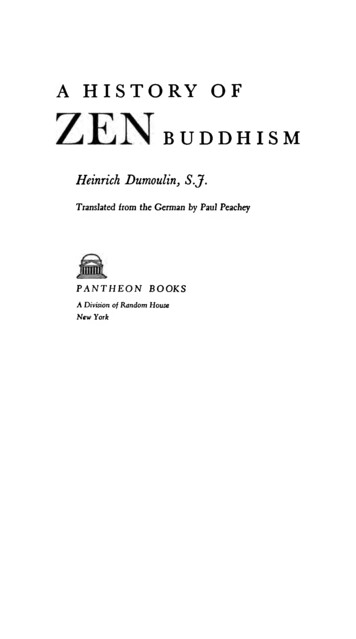
Transcription
A H I S T O R Y OFBUDDHISMHeinrich Dumoulin, S.J.Translated from the German by Paul PeacheyPANTHEONBOOKSA Division of Random HouseN ew York
A HISTORYOFZENBUDDHISM
A H I S T O R Y OFBUDDHISMHeinrich Dumoulin, S.J.Translated from the German by Paul PeacheyPANTHEONBOOKSA Division of Random HouseN ew York
Copyright, 1963, by Random House, Inc. 1959 by A. Francke A G VerlagAll rights reserved under International and PanAmerican Copyright Conventions. Published in NewYork by Pantheon Books, a Division of Random House,Inc., and simultaneously in Toronto, Canada, byRandom House of Canada, Limited.Library of Congress Card Catalog Number 6 2-17386Manufactured in the United States of America.by H. W olff, New York
PrefaceInterest in Zen Buddhism has grown continually since this bookwas first published in German. Although it was then thoughtnecessary to preface the work with some remarks for the benefitof Western readers about Zen and its living values, a generalknowledge of Zen Buddhism can now be presupposed. To besure, this knowledge is often and in many respects inadequate,distorted, or even altogether false. In the wake of the ‘'Zenboom” in the United States, there originated “ Beat Zen,”“ Square Zen,” and other distorted forms which must be con sidered caricatures rather than true expressions of Zen Buddhism.A French scholar who had lived in Asia for many years once saidto me: “ One has to distinguish between Buddhism in Asia andBuddhism for Europeans.” This very relevant remark applies toZen Buddhism as well. Zen Buddhism in Asia can only be under stood in terms of its Asian development—its origin in China,most likely in the sixth century, the meditation tradition of athousand years' duration upon which it was based, and its thir teenth-century transplantation to Japan where it reached itsfullest and highest development. Hence, in order to obtain areliable and correct knowledge of Zen Buddhism, our interest isdirected towards a study of its history.
vi PrefaceIfeel very grateful to my Japanese friends who, shortly aftermy entrance into the postgraduate course of the Science of Re ligions Department of the then Tokyo Imperial University in1936 (one year after my arrival in Japan), introduced me to ZenBuddhism and encouraged me to study its history, for I havecontinually found this a most fascinating subject of study. Twoof my fellow students, themselves believers in Zen, used to ac company me on visits to Zen monasteries in Tokyo and its vi cinity, and invited me to read with them a Zen text, the famouskoan collection Mumonkan. This koan collection presents avivid reflection of the history of Zen Buddhism in China duringa span of nearly five centuries. Out of this study came a shortsummary of the history of Chinese Zen Buddhism, which waswritten in German and first published in Monumenta Serica(Vol. V I, 1941, pp. 40-72).*At our first meeting Mrs. Ruth Fuller Sasaki suggested that Iwrite a complete history of Zen Buddhism. At that time I de clined laughingly. However, the importance of such a scholarlyendeavor always remained in my mind, and from that time onI tried to extend my studies of the history of Zen Buddhism indifferent directions, and when time was available, I began towork upon a synthesis of these studies. Whenever possible Itried to fill in gaps and to indicate the connection of movementsand events. Naturally, it was impossible to shed light on all theobscurity, for in the history of Chinese Zen Buddhism, as inthe whole of the history of Chinese Buddhism, there is stillmuch unexplored territory. The personality of Bodhidharma aswell as the beginnings of Zen (Ch.: CKan) in China remainsuncertain. The fusion of Buddhist and Taoist elements hadprobably already progressed far in the schools of contemplationwhich preceded Zen. The precise proportion of Taoist influx* Later, Mrs. Ruth Fuller Sasaki translated it into English and publishedit with her admirable annotations and indices (The Development of ChineseZen after the Sixth Patriarch, in the Light of Mumonkan, New York,a953)-
Preface viiinto Zen Buddhism can as yet hardly be gauged. Even more im portant would be to ascertain the exact character of this influx.Further investigation will certainly enrich as well as correct ourpicture of the history of Zen.This book is of an historical nature and is intended to giveto the reader a faithful account of the historical development ofZen Buddhism as far as this is possible at the present time. TheGerman edition was well received by the specialists in this field.The historical accuracy of the work was acknowledged by Bud dhist scholars of the first rank. The title of the American edition,A History of Zen Buddhism, stresses even more clearly its his torical orientation.However, Zen is not merely of historical interest; it has im portance for the present day. This conviction never left me dur ing my historical studies. At the same time I am convinced ofthe eminently spiritual function of history. In the preface to theGerman edition I expressed this in saying: “ Perhaps there is noother way that leads as surely to the very essence of things asinquiring into their historical development. Certainly, by itsvery nature, historical presentation will always be imperfect, forhistory in its complex interrelationships is mysterious and enig matic, but at the same time sobering and disenchanting. . . .History reveals the form and leads to the essence of things. Inhistorical research we are guided by the things themselves, andwe try to comprehend their response and their teaching. Theobject of this book is to put the reader into as close a contactwith Zen as possible, to elucidate its inner form from history,and to make its living values apparent.”It is impossible to thank one by one the many persons whowere of help to me during the long years of preparing the Ger man original of this book and translating it into English. Onlya few names can be mentioned. The Japanese professors ReihoMasunaga, Hajime Nakamura, and Shokin Furuta have helpedme in my Zen studies in many ways and contributed much use-
viii Prefaceful information. Through the kind offices of Mrs. Sasaki thedoors of the Zen monasteries of Kyoto with their memorable arttreasures were opened to me. Mrs. Sasaki, moreover, not onlyput her library at my disposal during the writing of the originaland its rendition into English, but also had the kindness to assistin the revision of both. Thanks to the co-operation of Fr. Hein rich Busch and Fr. Gerhard Schreiber, I was able to make use ofthe Oriental Library of the Monumenta Serica. Fr. WilhelmSchiffer and Fr. Franz Mohr assisted me in procuring the illus trations. Last, but not least, I am deeply grateful to the Rever end Mr. Paul Peachey who undertook the wearisome task ofmaking the basic English translation of the entire book. To allthese and the many others who helped in the composition andpublication of this book, hearty thanks.,Tokyo 1962Heinrich Dumoulin
ContentsPreface1vThe Mystical Element in Early Buddhism andHinayana 33Buddhism and Mysticism5Shakyamunit the Enlightened OneHinayanist Meditative Exercises8Nirvana as the Goal of the Mystic W a y2Mysticism W ithin MahayanaThe Bodhisattva Ideal1922Buddhology and Nirvana31818Perception of Life and MysticismThe Beginnings of Mahayana 1428The Mahayana Sutras and Zen The Position of Zen in Intellectual HistoryPrajnaparamita— Transcendental Wisdom323234Religious Cosmotheism in the Avatamsaka Sutras38The Vimaliklrti Sutra— The W a y of Enlightenment for All42The Psychological View of the Process of Enlightenment in theLankavatara Sutra45
4The Anticipation of Zen in Chinese Buddhism“ W isdom Not Being Knowledge”58T/ie Suddenness of Enlightenment60Zen Patriarchs of the Early Period 676772Disciples and FollowersSchisms and Oppositions680The High Period of Chinese ZenThe Sixth Patriarch 8888“ To See into One's Nature and Become a Buddha”The Monastic Life9196Zen Masters of the T ’ang Period75357Kumarajiya and BuddhabhadraBodhidharma5252The Historical Understanding of ZenThe Introduction of Buddhist Meditation into China5 102Peculiarities of the “ Five Houses” 106107The Circular Figures (Wei-yang Sect)The Pass of a Single W ord (Y iin-min Sect)108The Interpenetration of the Attributes of Being (Fa-yen Sect)The Five Ranks (T s’ao-tung Sect)112Shouting and Beating (Lin-chi Sect)8118Spread and Methodological Development During theSung Period 123Zen and the Spirit of the Age123The Rise of the Kdan in the Lin-chi Sect126110
The Psychological Structure of the K6an9129132The Two Main Streams of ZenThe Transplanting of Zen to Japan13713 7Preliminary DevelopmentsEisai 139The Flowering of Rinzai Zen in the Kamakura Period10The Zen Master Dogen159166Religious Metaphysics1115 115 1His Life and W orkZazen The Cultural Influence of Zen in the M uromachiPeriod 175The Spread of Zen Under the Rule of the AshikagaApproaches to the People179187The Unfolding in Japanese Culture12The First Encounter Between Zen andChristianity 198Friendly and Hostile Contacts199204Doctrinal Disputes2 10Cultural Adaptations and InfluencesThe Christian Daimyo and the W a y of Tea13142Zen in the Modern Japanese AgeThe Obdku Sect228Renewal of Zen2 31Basho and Zen's Love of Nature235 2 13225175
14The Zen Mysticism of Hakuin 242242Life and W ork247Mystical ExperiencesThe Great Doubt and the Great EnlightenmentZen Sickness260Personality and the Japanese Character15The Essence of ZenHistory and Form 269269The Experience of Satori273The Psychological Interpretation of SatoriNatural MysticismNotes291BibliographyIndex327264282315276
IllustrationsFOLLOWING PAGE 1 7 81.Bodhidharma, by a painter of the school of Mu-ch'i. Originalin the Daitokuji, Kyoto.2.Hui-k’o, by Mincho. Original in the Tofukuji, Kyoto.3.Eisai, wooden sculpture, worshipped in the Kenninji, Kyoto.4.Lin-chi, by Jasoku. Original in the Daitokuji, Kyoto.5.Hakuin, self-portrait.6.Dogen, self-portrait.7.Tofukuji (Kyoto), Butsuden.8.Tofukuji (Kyoto), Zendo, of the Kamakura period.9.Ryoanji (Kyoto), stone garden by Soami.10.Shinjuan (Kyoto), entrance to the tearoom.11.Landscape, spring, by Sesshu.12.Landscape, winter, by Sesshu.13.Monks at the Dokusan, “ going alone” to visit the Zen masterfor spiritual guidance.14.Novice asking for admission in the Zen monastery.15.Monks going to beg alms (takuhatsu).16.Zen monks at manual work.
W e would like to thank the following for the photographs which they madeavailable to us: the Reverend F . Mohr for photographs number 1, 2, 3, 4,7, and 8; the Reverend W . Schiffer for photograph number 5; Mr. T .Okamoto for photograph number 9; Benrido Publishing Company, Kyoto,for photographs number 1 1 and 12 ; Daihorin Publishing Company , Tokyo,for photographs number 13 and 16 ; the Japan Travel Bureau, Tokyo, forphotographs number 14 and 15 .
A HISTORYOFZENBUDDHISM
1The Mystical Element inEarly Buddhism and HinayanaBuddhism and MysticismWhen, in the nineteenth century, Buddhism for the first timewas disclosed to the West, the rationalist scholars of Europethought they had found in it the coveted credo of reason, with out God and revelation, without heaven and hell, or soul andimmortality. Further research, however, soon taught them other wise. Not only did the later Buddhism of the Great Vehicle(mahdydna) exhibit all the despised “ irrational” phenomena ofreligiosity such as miracles, saints, the cult and veneration ofimages and relics, and superstition and magic as well, but alsothe Buddhism of the canonical writings showed itself, on closerstudy, to be a religion which transcended the worlds of senseand reason. Everything that the sutras relate of the life andwork of Shakyamuni—his words to his disciples, his profoundcontemplation, his sayings and demeanor—all bear witness toa man mightily stirred by religion, who, with a high sense ofmission, opened a new way to knowledge and final release. ThusBuddhism could not be fitted into the mold of a religion ofpure reason.But Christian scholars likewise had to concede to the forceof the facts and recognize the religious character of Buddhism.Up until that time the term “ religion” had designated the re-
4 Mysticism in Early Buddhism and Hinaydnalationship of man to a transcendent personal God or to aDivine Being. Now the concept had to be broadened to em brace the phenomenon of Buddhism. Today Buddhism is gen erally recognized by scholars as a religion, and, because of itshistorical and contemporary significance, it ranks among theworld’s great religions. The basic trait of Buddhism is its strivingfor otherworldly salvation.1At the same time, the concept of mysticism has been con siderably enlarged. Since the definition of mysticism developedwithin Christianity, which calls for the immediate experienceof the personal God through the knowing and loving soul, doesnot apply to many unmistakably mystical phenomena in nonChristian religions, it has become necessary to place alongsidethe supernatural mysticism of grace the concept of naturalmysticism. Admittedly this concept entails certain difficulties,and frequently it is not sharply enough defined and differen tiated. For the moment we shall content ourselves with ageneral description, and designate as mysticism all efforts ofman to elevate himself to a supercosmic, supersensory spherewhich he experiences immediately. The supercosmic domainstands in necessary relationship to the Absolute with whichman in mystical experience establishes some kind of contact.Where these three essential elements are manifest—namely,where man transcends the sense realm, breaks through the limitsof normal psychic experience, and reaches the Absolute—therewe can speak of mysticism. The respective strength of each ofthese three elements varies greatly from case to case, but nonemust be missing entirely. The sphere of mysticism is thus clearlydifferentiated from phenomena such as sorcery, magic, and evenspeculative metaphysics. Since contact with the Absolute be comes, in mystical experience, a means of salvation, Buddhism,precisely because of its mystical element, must be regarded asa religion. Buddha, and those who followed him, saw in mystical
Shakyamuni, the Enlightened One 5enlightenment the 'Vehicle of salvation” that carried them be yond this world to the "other shore.”The mystical element is an essential part of Buddhism. Themultiplicity of phenomena in the religion of Buddha has oftenamazed scholars and laymen. There is hardly a religious motifor manifestation which has not been used down through thecenturies by one Buddhist sect or another. In vain does oneseek a bond that would embrace all these numerous contra dictory forms. And yet, despite the absence of a common de nominator, Buddhism constitutes a whole. The specific essenceof Buddhism is nowhere so clearly apparent as in the mysticismthat pervades the whole of this religion. The manifold Buddhistmanifestations—the rigorous moral code of the early monasticcommunities, the daring metaphysical speculations of the GreatVehicle, the intimately confident prayer of the believers inAmida, the magic rites of Shingon and Tendai—all these areimmersed in the mystic twilight that envelops the disciples ofthe Buddha, each in his own way.Shakyamuni, the Enlightened OneThe nature of Buddhist sources does not permit us to distinguishclearly between history and legend in the life of Shakyamuni.2According to the majority of Buddhologists, those incidentswhich are transmitted alike in the Pali Canon and the Sanskritsources can be regarded as containing a historical core. Allrecords tell us that the decisive turn in the Buddha's career wasbrought about by a mystical experience. As the early sutras re late, Prince Siddhartha of the house of Shakya chose a life ofwandering to learn the meaning of suffering, and became theWise (muni) and Enlightened One (buddha), who teaches thepath of redeeming knowledge. The accounts all stress that onlyafter long ascetic exertions was Shakyamuni able to enter the
6 Mysticism in Early Buddhism and Hlnaydnatrue way of liberating meditation, and emphasize thereby theBuddhist manner of meditation as distinct from the practicesof self-castigation in Yoga. The renowned Brahmans to whomShakyamuni first went recommended to him dangerous austeri ties which he carried out fearlessly to utter exhaustion. But hedid not reach liberation. Only after he took nourishment again,which occasioned the departure of his five fellow ascetics, andentered the new path of meditation, did he achieve his goal.While he sat beneath the pipal tree, dead to his senses andabsorbed in deep meditation, his spiritual eye of illuminationwas opened. According to the account in the Mahdsacca Suttahe thereupon went immediately to Benares, where he “ set inmotion the Wheel of the Doctrine/' basing his authority di rectly on his illumination. When he met his five comrades inasceticism, they mocked him. But Shakyamuni faced them inhis newly acquired dignity as the Enlightened One, declaring:“ The Perfected One is the holy, highest Buddha." This word,from now on recurrently on his lips, establishes his authority asthe founder of a religion and a leader of men to salvation. Inthe sermon at Benares, Buddha developed the doctrines of theFour Noble Truths and of the Middle W ay between the twoextremes of asceticism and indulgence. W e may assume thatthese doctrines comprise the content of his enlightenment.Legend has removed Shakyamuni from the realm of themerely human and has attributed extraordinary powers to him.The Exalted One is said to have possessed the capacity to pene trate bodies and to read thoughts. The might of his spirit wassuch that it gave him power over sickness. He communicatedwith supernatural beings and was able to recall his previous in carnations. Indian imagination elevated the figure of Buddhato a superhuman level. His miraculous powers made him “ thegreatest of all Yogis.” 3 The mystical element comes stronglyto the fore in the legends. The Bodhisattva, who in “ thought ful consciousness" entered his mother's body, relaxes there in
Shakyamuni, the Enlightened One 7the posture of Yoga meditation, sitting with crossed legs. Therehis mother, Maya, sees him—herself caught up in a state ofhigher consciousness. As a youth, the Prince once went with hiscompanions into the country and, beneath a rose tree, sank intoa deep meditation in which he ascended from the lowest to thefourth dhydna stage. The youth, encircled by the “ halo of con templation/' aroused the admiration of all. Tradition also tellsof the many Yoga-like practices of Shakyamuni before heachieved Buddhahood. As he lived, so he died, a mystic.The sutra relates how the Enlightened One at an advancedage, after he had for a time postponed death through the powerof his conscious will, decided to allow nature to run its courseand voluntarily relinquished the will to live. The Master nowspoke his final words of admonition to his disciples. While hisbody lay in mortal illness beneath a sola tree in the grove ofKusinara, his spirit was absorbed in contemplation. He ascendedthrough the four stages of dhydna, then hastened through thefive ecstatic states, returning finally through these same stagesto the first dhydna. His spirit now mounted a second time tothe fourth dhydna and from there entered perfect nirvana (Pali:parinibbana) .4The mystical elements, which in legend and tradition per meate the figure of the Buddha, obscure his person as much asthe miraculous and the supernatural attributes. Even thoughthe accounts in the Pali Canon reflect a distinct historicalreality, the Buddha does not emerge as a perfectly tangibleperson. The mystic traits veil his human countenance. Sincewe cannot know with complete certainty a single actual wordor event from the life of Shakyamuni, the original Buddhismcannot be fully reconstructed. But one thing is certain. Buddhalives in his religion as the highest, most perfectly EnlightenedOne, who through his mystic vision gained the supreme andsaving knowledge. Throughout all Buddhism the mighty con fession of his disciple Sariputra sounds forth like the roar of a
8 Mysticism in Early Buddhism and Hlnaydnalion: “ This, Lord, is my faith in the Holy One: that there neverhas been nor will be, nor is there at this time any other asceticor Brahman greater or wiser than he, the Enlightened One.” 5Artists have hit upon his essence when they have presented theBuddha of the house of Shakya as the great contemplative whohas entered nirvana.Hinayanist Meditative ExercisesBuddhology for some time has devoted its best energies to prob ing the original character of Buddhist doctrine, but thoughachieving valuable results it has not succeeded in reaching itsmajor objective. Critical textual studies of both the Pali Canonand the Sanskrit works do not permit definite or final conclu sions regarding Buddha’s life and teaching in precanonicalBuddhism. Usually the Four Noble Truths and the EightfoldPath are regarded as the primitive Buddhist credo. Undoubtedlycertain Yogic elements also belong to the primitive substanceof the Buddhist religion. Even in the earliest times the FourTruths were practiced and experienced in meditation.6 Indeed,the exercises of Buddhism are to be distinguished from Yogachiefly in that the Buddhists, remaining true to the MiddleWay, reject violent exertions and bodily chastisements.The sutras of the Pali Canon present a wealth of descriptiveaccounts of mystic stages and states which are to be achievedby systematic exercises. This textual material, though engulfedin repetition and accretion, has been examined and put intoorder by Buddhist research.7 By placing the four dhydna stagesat the center and grouping all other phenomena about them,Heiler sketches a logical over-all figure that far outdoes reality.For the impartial reader of Buddhist literature, many dishar monies, tangles, and contradictions remain. Thus, for example,the thirty-seven elements which, according to the Mahaparinibbdna Sutta, the Buddha is said to have explained to his disciples
Hinayanist Meditative Exercises 9shortly before his death as the essence of the way of enlighten ment, are anything but a systematic summary of the mysticaldoctrine of Buddhism. W e will limit our discussion here to abrief evaluation of those fragments most important for thefurther development of our present study.The Eightfold Buddhist Path of salvation leads to “ right con centration” (samadhi). Thus the impression could be createdthat the first seven stages are the means to this final goal.8 Buton the other hand, one finds in the Hlnayana sutras anothermore comprehensive formulation according to which the wayof salvation begins with observance of the rules of morality(sila) and then leads to concentration (samadhi) in which thesaving knowledge (pahhd) is acquired, which in turn is in separable from liberation (vimutti). This fourfold formula,which occurs in many texts and is repeated eight times in theMahaparinibbana Sutta, represents a blueprint of the mysticaldoctrine of salvation in Hlnayana Buddhism. While contem plation is merely the means, it occupies as such the centralposition. Moral discipline is directed toward concentration, forit is the knowledge acquired in concentration that leads to finalsalvation. In addition to the familiar five commandments, theHlnayana Buddhist moral code demands the monastic celibacyof religious life (brahmacarya) , the bridling of the senses, vigi lance of the spirit, and self-control as prerequisites conduciveto concentration.9 In the meditative scheme recommended bythe Pali Canon, the Four Immeasurables (appamahha), whichare also called the Four Brahma Abodes (brahmavihara) orAwakenings (bhavand), exhibit especially close relations tomorality. In this exercise, the monk extends successively, in thedirections of the four cardinal points, the powers that fill hisheart: first, the power of benevolence (metta); then of com passion (karund); then, of sympathy (mudita); and finally, ofequanimity (upekha). Thus “ he permits the power of benev olence (of compassion, sympathy, equanimity), which fills his
io Mysticism in Early Buddhism and Hlnayanamind, to extend over the whole world.” 10 Through these ex ercises the virtues of benevolence, compassion, sympathy, andequanimity are acquired. This meditation is similarly recom mended in the Yoga Sutra.“ Concentration is a purely spiritual activity; the seated pos ture of the body has merely auxiliary significance,” Heiler em phasizes,11 and yet Buddhism knows of no advanced meditationor higher mystic state apart from the cross-legged posture. Thisposture has belonged to the heritage of India from time im memorial. The search for its origin takes us to the dawn ofhistory, as is shown by the figure of a meditating god excavatedin Mohenjo-Daro on the Indus River.12 The Upanishads andthe early Hlnayana sutras tell of pious ascetics and disciples ofBuddha who sat in meditation beneath shady trees in coolgroves and there experienced unity with Brahma or recognizedthe sorrow and vanity of all things earthly, thus acquiring a fore taste of nirvana repose.Quite similarly, breathing exercises belong to the ancientIndian Yoga heritage. Whereas some Yoga practices seek to sup press the awareness of breathing as the basic vital function, the“ excellent and joyful” control of breath praised by the Buddhain the Hlnayana sutras makes respiration conscious. “ The monkbreathes in and out consciously. When he breathes in long, heis conscious—'I will breathe in long/ When he breathes outlong, he is conscious—'I will breathe out long/ When hebreathes in short, he is conscious—'I will breathe in short/When he breathes out short, he is conscious—'I will breatheout short/ ” 13 The Buddhists reject the coercive inhibition ofbreathing practiced in Yoga. At the fourth stage of dhyanabreathing automatically becomes imperceptible.The four stages of dhyana (Pali: jhana) and the four realmsof infinity (arupa), which in the Pali Canon are combinedfrequently in a series with a ninth stage of the destruction ofconsciousness and sensibility (nirodha), form the core of the
Hinayanist Meditative Exercises 11mystic practices in Hlnayana Buddhism. After the conquestof the five hindrances (nivarana)—desire, hatred, slothfulness,fear, and doubt—begins the ascent through the four stages ofdhyana. In the first stage, that of inner composure and cessationof desire, there still remains the image of objects, and a feelingof delight arises. In the second stage, the release from the outerworld is accomplished and the consideration of objects hasdisappeared, but joy permeates the body. In the third stage, thisfeeling of joy gives way to equanimity, and spiritual contempla tion becomes consummate. The fourth and highest of thedhyana stages is the world-removed state of equanimity(upekhd), free of joy and suffering alike. Meditating on infinity,the monk strides successively through the realms of the in finity of space, of the infinity of consciousness, of nothingness,and of the sphere beyond consciousness and unconsciousness.The subsequent “ destruction of consciousness and sensibility”signifies, not the final liberation in nirvana, but an ecstatic state.Among the various ways of meditation the four stages ofdhyana take priority. According to tradition, the Buddha passedfrom the fourth dhyana stage into nirvana. This stage opensthe door to all the higher spiritual powers which, in the mannerof Yoga, play an important role in Hlnayana Buddhism. Amongthe magic powers (iddhi) acquired in meditation are includedextraordinary states of consciousness and unusual bodily ca pacities, such as levitation, self-duplication, bodily penetration,invisibility, touching of sun and moon, clairaudience, andothers.14 A further miraculous fruit of the dhyana states isthreefold knowledge (tevijja), namely, the recollection of pre vious existences, a knowledge of the destiny of all beings in thecycle of rebirths, and the knowledge of suffering and its con quest. This supreme knowledge, which is the point of departurein Buddhist doctrine, is now perfectly comprehended on thehigher mystical level; thus the state of the saint (arhat) isreached.
12 Mysticism in Early Buddhism and HinayanaIn this connection mention must still be made of two aids tocontemplation which survive in Zen, though all other practicesof Hinayana have disappeared completely. The schematic ob jects of consideration (kammatthana) , detailed especially inthe Mahdsattipatthdna Sutta, are directives to psychic techniquerather than to spiritual reflection. And yet they place the monkin that grave mood, engendered by contact with the funda mental truths of the transitoriness of life (anicca), the un reality of existence (anattd), and universal suffering (dukkham),which is a prerequisite to success in all Buddhist meditation.Zen knows no thematic considerations similar to the Hinayanistapproach. However, the beginner is taken through exerciseswhich, in a fashion similar to the recommendations of thesutras to fix the attention on the impurities and ugliness of thebody, are designed exclusively to unmask beauty and to leadto an experience of human frailty. The Zen masters speak muchof death and renunciation to their disciples, so that throughtheir grasp of these basic truths illumination may come themore easily. The Zen monastery is as much pervaded by anawareness of transitoriness as are the meeting places of thebhikkhu.The kasina exercise, likewise, leads to the state of contempla tion. In this exercise an extreme degree of concentration isachieved through fixing the attention on a physical object. Themonk gazes steadfastly at a circle or disk of clay or earth, orinto a vessel of water, or into a fire, or at a treetop waving inthe breeze (kasina of the four element
summary of the history of Chinese Zen Buddhism, which was . other way that leads as surely to the very essence of things as . The Christian Daimyo and the Way of Tea 213 13 Zen in the Modern Japanese Age 225
